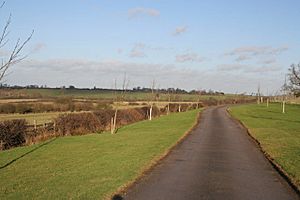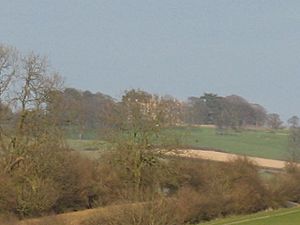Ingarsby facts for kids
Ingarsby is a special place in England because it's one of the best examples of a deserted medieval village that is still well-preserved. It's located about 6 miles (10 km) east of Leicester, near Houghton on the Hill. Most of the old village site is now a scheduled monument, which means it's protected by law because of its historical importance.
Contents
Ingarsby's Early History
The village of Ingarsby was likely started by a Danish person named Ingwar sometime in the 800s or 900s. That's why it was called "Ingwar's village." By 1086, when the famous Domesday Book was written, Ingarsby was a good-sized village with 32 families living there.
Why Ingarsby Became Deserted
In 1352, a dozen families lived in Ingarsby. The land was owned by the Daungervill family, but most of it was given to Leicester Abbey. Later, in 1469, the abbey decided to change how the land was used. They "enclosed" all the village land, which meant they put fences around it. They then turned most of it into pastures for sheep and cattle. This change meant the farmers who lived there had to leave, and the village became deserted.
When the King took control of church lands in 1540 (a time called the Reformation), Ingarsby was sold. It was one of the most valuable properties in Leicestershire at that time.
Ingarsby Old Hall
After Leicester Abbey was closed down, the Cave family gained a lot of land, including the Manor of Ingarsby. Sir Brian Cave, who was the Sheriff of Leicestershire, built Ingarsby Old Hall around the 1540s. The hall was originally surrounded by a moat on three sides, like a small castle.
Later, in 1621, Sir Robert Bannister bought the manor and added more parts to the hall.
What You Can See Today
Today, you won't find many buildings left at Ingarsby. Instead, you can see clear rectangular mounds in the ground. These mounds show where the houses of the old farmers used to stand. You can also see "hollow ways," which are like sunken paths. These were the streets and lanes where people walked and carts traveled in the medieval village.



